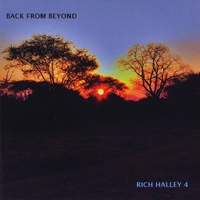Home » Jazz Articles » Album Review » Rich Halley 4: Back From Beyond
Rich Halley 4: Back From Beyond
The stylistic variety of Halley's work, from his free-bopping tenor- bass-drums power trios of the early 2000s to the more elaborately scored Charles Mingus-meets-Sun Ra little big band projects he headed in the 1980s, is as deep as it is broad. The only constants are their consistent musical excellence and the sort of artistic energy that comes from intense curiosity. Halley's current band, a quartet featuring indefatigable trombonist Michael Vlatkovich, leavens the freewheeling intuitive approach of his more recent trio work with the more tightly focused and compositionally oriented aspects of his earlier material. Interestingly, Vlatkovich was a regular member of Halley's earliest and longest lived large ensemble, The Lizard Brothers.
Drummer Carson Halley and bassist Clyde Reed have quickly developed into a formidable rhythm tandem, while Halley and Vlatkovich are near-perfect as a front-line duo. Halley's broad, never-strident tenor sound has that old-school patina and graininess that pairs effortlessly with Vlatkovich's wickedly chameleonic array of trombone sounds and possibilities. Halley's compositions comprise the bulk of Back From Beyond, and provide a variety of rhythmic settings for the always-exploring quartet. He indulges a propensity for abstractly funky backbeats on "Back From Beyond," "Section Three," and "Broken Ground." The title track is a particularly pungent slow drag that sounds a little like something Henry Threadgill could have written back in his Sextett days. Too bad it fades out. "Opacity" is a molasses crawl illuminated by Reed's eloquent bass and Carson Halley's pliant brushwork. Freely flowing, Ornette-inspired post-bop is prominent on both "Spuds" and "Basalt," while the spooky wood flute and primal rhythms of "The Mountain's Edge" suggest a soundtrack for a woodland ritual.
The centerpiece of Back From Beyond, however, is a trio of group-improvised pieces that show the truly amazing depth and range of this quartet. "Reorbiting" opens with a pensive bass-trombone dialogue until Carson Halley's inventive, machine-like percussion sets the music off onto an altogether different tangent before it reassembles somewhere close to where it began with Halley's tenor in the lead. The CD is rife with moments like this, little unexpected interruptions and diversions that somehow fit perfectly into a larger musical picture. A truly engaging listen.
Track Listing
Spuds; Section Three; Reorbiting--for Sun Ra; Solanum; Opacity; Continental Drift; Broken Ground; The Mountain's Edge; Basalt; Back From Beyond.
Personnel
Michael Vlatkovich: trombone, percussion, squeak toys; Rich Halley: tenor saxophone, wood flute, percussion; Carson Halley: drums, percussion; Clyde Reed: bass.
Album information
Title: Back From Beyond | Year Released: 2012 | Record Label: Pine Eagle Records
< Previous
Bob Willoughby: Jazz - Body and Soul
Next >
Our Path To This Moment
Comments
Tags
For the Love of Jazz
 All About Jazz has been a pillar of jazz since 1995, championing it as an art form and, more importantly, supporting the musicians who create it. Our enduring commitment has made "AAJ" one of the most culturally important websites of its kind, read by hundreds of thousands of fans, musicians and industry figures every month.
All About Jazz has been a pillar of jazz since 1995, championing it as an art form and, more importantly, supporting the musicians who create it. Our enduring commitment has made "AAJ" one of the most culturally important websites of its kind, read by hundreds of thousands of fans, musicians and industry figures every month.



















